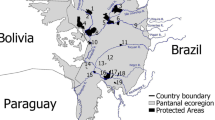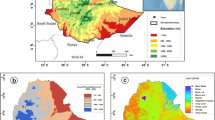Abstract
Climate warming must lead the mainly air temperature controlled permafrost to degrade. Based on the numerical simulation, the process of permafrost degradation can be divided into five stages, i.e., starting stage, temperature rising stage, zero geothermal gradient stage, talic layers stage, and disappearing stage, according to the shape of ground temperature profile. Permafrost on the Qinghai-Tibet Plateau (QTP) is generally considered a relic from late Pleistocene, and has been degenerating as a whole during Holocene. According to spatial-temporal compensation, the present thermal state discrepancy of permafrost in different areas on the QTP may correspond with their degradation stages. On the QTP, permafrost in the high and middle mountains belongs to temperature rising stage, the permafrost thermal state is transiting from late rising temperature stage to zero geothermal gradient stage that is distributed in the middle-low-mountains. Permafrost that is in a zero gradient stage mainly appears in the high plateau and valley, whereas the transition from zero gradient stage to talic layers stage of permafrost is located in the vicinity of the lower limit of permafrost, and permafrost is disappearing from margin of perennially frozen ground. There are two modes of perennially frozen ground thawing, thawing from top to bottom and thawing from bottom to top respectively. During the temperature rising stage, when the heat flux in the perennially frozen soil layer is less than that in the unfrozen soil underlying frozen soil layer, the geothermal flux is partly used to thaw the base of permafrost, and permafrost thaws from bottom to top. With the decrease of thermal gradient in the perennially frozen ground, the heat that is used to thaw permafrost base increases, and geothermal heat will be entirely consumed to thaw the base of permafrost until the temperature gradient reaches zero thermal gradient state. On the other hand, the disappearance of permafrost may be delayed by “thermal offset” and “seasonal offset” effects in the upper of permafrost layer. When ground surface temperature rises to the level that can counteract the thermal offset effect, heat accumulation in the active layer would start, and the thickness of the active layer increases until a talic layer to appear. This process can be intensified by the “seasonal anti-offset effect”.
Similar content being viewed by others
References
Intergovernmental Panel on Climate Change (IPCC). Global climate projections. In: Solomon S, Qin D, et al., eds. Climate Change 2007: The Physical Science Basis. Cambridge and New York: Cambridge University Press, 2007
Zimov S A, Schuur E A G, Chapin III F S. Permafrost and the global carbon budget. Science, 2006, 312: 1612–1613, doi: 10.1126/science.1128908
Turetsky M R, Wieder R K, Vitt D H, et al. The disappearance of relict permafrost in boreal north America: Effects on peatland carbon storage and fluxes. Glob Change Biol, 2007, 13: 1922–1934, doi: 10.1111/j.1365-2486.2007.01381.x
Lyle R, Hutchinson D J. Influence of degrading permafrost on land-sliding processes: Little Salmon Lake, Yukon Territory, Canada. In: Nadim F, Pöttler R, Einstein H, et al., eds. Geohazards: ECI Symposium Series. Volume P7. Berkeley: The Berkeley Electronic Press, 2006. 1–10
Fischer L, Kääb A, Huggel C, et al. Geology, glacier retreat and permafrost degradation as controlling factors of slope instabilities in a high-mountain rock wall: The Monte Rosa east face. Nat Hazards Earth Sys Sci, 2006, 6: 761–772
Smith L C, Sheng Y, Macdonald G M, et al. Disappearing Arctic lakes. Science, 2005, 308: 1429, doi: 10.1126/science.1108142
Vitt D H, Halsey L A, Zoltai S C. The changing landscape of Canada’s western boreal forest: the current dynamics of permafrost. Can J For Res-Rev Can Rech For, 2000, 30: 283–287
Zhang S Q, Wang Y G, Zhao Y Z, et al. Permafrost degradation and its environmental sequent in the source regions of the Yellow River (in Chinese). J Glaciol Geocryol, 2004, 26: 1–6
Wu Q B, Dong X F, Liu Y Z, et al. Responses of Permafrost on the Qinghai-Tibet Plateau, China, to Climate Change and Engineering Construction. Arct Antarct Alp Res, 2007, 39: 682–687
Jin H J, Wei Z, Wang S L, et al. Assessment of frozen ground conditions for engineering geology along the Qinghai-Tibet Railway and Highway. Eng Geol, 2008, 101: 96–109
Osterkamp, T E. Characteristics of the recent warming of permafrost in Alaska. J Geophys Res, 2007, 112: F02S02
Pavlov A V. Permafrost-climate monitoring of Russia: Analysis of field data and forecast. Polar Geogr, 1996, 20: 44–64
Wu Q B, Zhang T J. Recent Permafrost Warming on the Qinghai-Tibetan Plateau. J Geophys Res, 2008, 113: D13108
Sharkhuu N. 2003: Recent changes in the permafrost of Mongolia. In: Phillips M, Springman S M, Arenson L U, eds. Proceedings of the 8th International Conference on Permafrost, 21–25 July 2003, Zurich, Switzerland. A.A. Balkema, Lisse, the Netherlands. 1029–1034
Harris C, Mühll D V, Isaksen K, et al. Warming permafrost in European mountains. Glob Planet Change, 2003, 39: 215–225
Jin H J, Zhao L, Wang S L, et al. Thermal regimes and degradation modes of permafrost along the Qinghai-Tibet Highway. Sci China Ser D-Earth Sci, 2006, 49: 1170–1183
Lunardini V J. Climatic warming and the degradation of warm permafrost. Permafrost Periglacial Process, 1996, 7: 311–320
Anisimov O A, Nelson F E. Permafrost zonation and climate change the Northern Hemisphere: Results from transient general circulation model. Clim Change, 1997, 35: 241–258
Li X, Cheng G D. A GIS-aided response model of high altitude permafrost to global change. Sci China Ser D-Earth Sci, 1999, 42: 72–79
Nelson F E, Outcalt S I. A computational method for prediction and regionalization of permafrost. Arct Alp Res, 1987, 19: 279–288
Li S X, Cheng G D, Guo D X. The future thermal regime of numerical simulating permafrost on Qinghai-Xizang (Tibet) Plateau, China, under climate warming. Sci China Ser D-Earth Sci, 1996, 39: 434–441
Nan Z T, Li S X, Cheng G D. Prediction of permafrost distribution on the Qinghai-Tibet Plateau in the next 50 and 100 years. Sci China Ser D-Earth Sci, 2005, 48: 797–804
Smith M W, Riseborough D W. Climate and the limits of permafrost: A zonal analysis. Permafrost Periglacial Process, 2002, 13: 1–15
Xu X Z, Wang J C, Zhang L X. Physics of Frozen Soils (in Chinese). Beijing: Science Press, 2001. 1–351
Wen Z, Sheng Y, Ma W. Numerical evaluation of EPS application to embankment of Qinghai-Tibetan highway. Cold Region Sci Tech, 2005, 41: 235–247
Ding D W, Guo D X. Preliminary discussions on permafrost evolution on the Qinghai-Tibet Plateau (in Chinese). In: Proceeding of the conference on Glaciology and Geocryology (Geocryolody). Beijing: Science Press, 1982. 78–82
Wu J C, Sheng Y, Yu H, et al. Permafrost in the Middle-East Section of Qilian Mountains (II): Characters of permafrost (in Chinese). J Glaciol Geocryol, 2007, 29: 426–432
Thompson L G, Yao T, Davis M E, et al. Tropical climate instability: The Last Glacial cycle from a Qinghai-Tibetan ice core. Science, 1997, 276: 1821–1825
Kang X C, Graumlich L J, Sheppard P. The last 1835 years climate changes inferred from tree ring records in Dulan region, Qinghai, China (in Chinese). Quat Sci, 1997, 1: 70–
Wang S L, Luo X R, Guo P F. The distributive characteristics of frozen ground in the east of Qianghai-Xizang Plateau. J Glaciol Geocryol, 1991, 13: 132–140
Jin H J, Zhao L, Wang S L, et al. Evolution of permafrost and environmental changes of cold regions in eastern and interior Qinghai-Tibet Plateau since the Holocene (in Chinese). Quat Sci, 2006, 26: 198–210
Sheng Y, Liu Y Z, Zhang J M, et al. Thermal regime in the embankment of Qinghai-Tibet Highway in permafrost regions (in Chinese). Prog Nat Sci, 2002, 12: 839–844
Wu Q B, Shi B, Liu Y Z. Interaction study of permafrost and highway along Qinghai-Xizang Highway. Sci China Ser D-Earth Sci, 2003, 46: 97–105
Zhou Y W, Qiu G Q, Guo D X, et al. Permafrost in China (in Chinese). Beijing: Science Press, 2000. 1–46
Shur Y L, Jorgenson M T. Patterns of permafrost formation and degradation in relation to climate and ecosystems. Permafrost Perigalcial Process, 2007, 18: 7–19
Wang B L, French H M. Soil wedge and ice wedge pseudomorphs and their paleoclimatic implications (in Chinese). J Glaciol Geocryol, 1991, 13: 67–76
Author information
Authors and Affiliations
Corresponding author
Additional information
This work was supported by National Natural Science Foundation of China (Grant No. 40871040), CAS Action Plan for the Development of Western China (Grant No. KZCX2-XB2-10), and Research Project of State Key Laboratory of Frozen Soil Engineering (Grant No. SKLFSE-ZQ-06).
Rights and permissions
About this article
Cite this article
Wu, J., Sheng, Y., Wu, Q. et al. Processes and modes of permafrost degradation on the Qinghai-Tibet Plateau. Sci. China Ser. D-Earth Sci. 53, 150–158 (2010). https://doi.org/10.1007/s11430-009-0198-5
Received:
Accepted:
Published:
Issue Date:
DOI: https://doi.org/10.1007/s11430-009-0198-5




